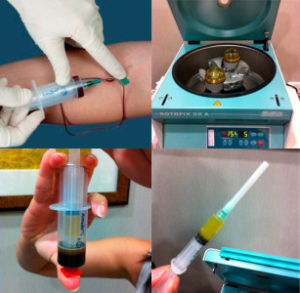Platelet-Rich Plasma (PRP)
In the past several years, much has been written about a preparation called platelet-rich plasma (PRP) and its potential effectiveness in the treatment of sports injuries.
Many famous athletes — Tiger Woods, tennis star Rafael Nadal, and many NFL and BPL players — have received PRP for various problems, such as sprained knees and chronic tendon injuries. These types of conditions have typically been treated with medications, physical therapy, or even surgery. Some athletes have credited PRP for their rapid return to competition.
Even though PRP has received extensive publicity, there are still lingering questions about it, such as:
- What exactly is platelet-rich plasma?
- How does it work?
- What conditions are treated with PRP?
- Is PRP treatment effective?
What Is Platelet-rich Plasma (PRP)?

Although blood is mainly a liquid (called plasma), it also contains small solid components (red cells, white cells, and platelets.) The platelets are best known for their importance in clotting blood. However, platelets also contain hundreds of proteins called growth factors which are very important in the healing of injuries.
PRP is plasma with many more platelets than what is typically found in blood. The concentration of platelets — and, thereby, the concentration of growth factors — can be 5 to 10 times greater (or richer) than usual.
To develop a PRP preparation, blood must first be drawn from a patient. The platelets are separated from other blood cells and their concentration is increased during a process called centrifugation. Then the increased concentration of platelets is combined with the remaining blood.

How Does Platelet-Rich Plasma Work?
Laboratory studies have shown that the increased concentration of growth factors in platelet-rich plasma can potentially speed up the healing process.
To speed up healing, the injury site is treated with the platelet-rich plasma preparation. This can be done in one of two ways:

- It can be directly injected into an area of injury to promote healing. For example, in an athlete with a hamstring muscle tear, we localise the exact site of injury with an ultrasound machine and then inject the platelet-rich plasma under direct visualisation. In our experience, this has helped many of our athlete patients shorten the healing time by half. We have treated runners, triathletes, MMA fighters, soccer players, cyclists and many other athletes from other disciplines. Most recently, one of our patients who had a prior hamstring tear re-injured his hamstring one week before the Boston Marathon. With PRP procedure, he managed to complete the whole race in a sub-4-hour timing!
- PRP may also be used to improve healing after surgery for some injuries. For example, an athlete with a completely torn heel cord may require surgery to repair the tendon. Healing of the torn tendon can possibly be improved by treating the injured area with PRP during surgery. This is done by preparing the PRP in a special way that allows it to actually be stitched into torn tissues.
Looking For A Reliable Sports-Related Orthopaedic Specialist?
Fast Medical Attention, Transparent Fees
Make an appointment for comprehensive care for your sports-related problems!
